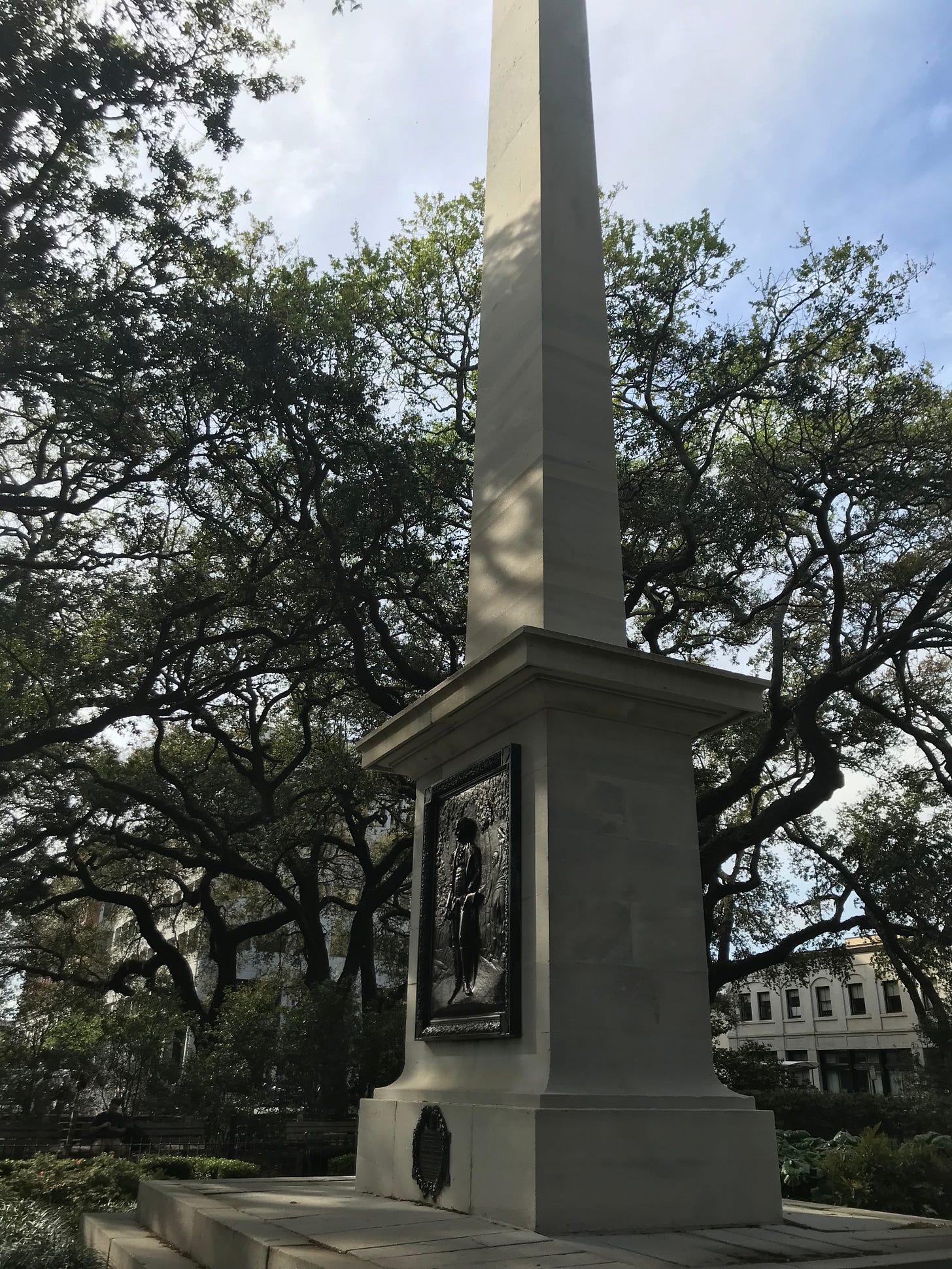Talkin' 'bout Natty Greene
Here are four big things you should know about the guy who seemed to have everything named after him around here.
Want to read stories like this sooner? Subscribe to the North Carolina Rabbit Hole for free.
In May of 2019, my family and I spent the night in Savannah to break up the drive to Disney World. As a North Carolinian and a parent, I highly recommend this. You can find a cheap hotel out by I-95. Your kids can burn their limitless energy by running through an endless variety of live oak and Spanish moss-encrusted squares. You can drink liquor right out in the open, on any corner or sidewalk you want. The entire city is a brewery that’s cool with kids.
Anyway, we all stumbled into Johnson Square, which is where I discovered this:
It’s a 50-foot-tall monument to Nathanael Greene. As phallic obelisks go, this one was too much for my iPhone to get in one shot.
Nathanael Greene, the celebrated American general from the Revolutionary War, has a habit of following me around. For one thing, I now work in Greensboro, which is one of several towns and counties named for him. I drank my fair share of Natty Greene beer, which is now hard to find (the brewery went bankrupt in October). My kids have tried to climb up the very large pedestal holding the very large bronze statue of Greene on a horse at the Guilford Courthouse National Military Park. I live in Oak Ridge, and the main drag through town was apparently the road that British general Charles Cornwallis followed in an attempt to catch Greene before he could cross the Dan River and get away. In short, this guy’s everywhere up here.
You, as I, may have already surmised that Greene is a big deal, if only because a lot of old things carry his name. But I recently learned a lot more about him, thanks to a great book that I picked up from the Greensboro Public Library. “Nathanael Greene,” by Gerald Carbone, is more than you could ever ask for if you’re curious about the guy. I highly recommend picking up a copy, but here are four things about Greene that you use RIGHT NOW to impress your history-unaware friends:
1. He Ran Away. A Lot.
Technically, you win a battle by being the person who ends up with the property you’re fighting over. Greene, when he took over the southern command of the American army, lost quite a bit. He, often, had fewer men than the British general he was fighting, and his men were usually untrained militia (SIDE NOTE: I am shocked by the amount of times that Greene asked his superiors to send shoes and clothes because his men were basically if not literally butt-ass naked). So, Greene would attack, pick off a bunch of British, and then run away. He was like a swarm of mosquitoes in summer. Sure, you can sit outside for a while, but you can never swat enough of them to prevent you from saying “oh, screw this,” and eventually heading back indoors.
The best example of this is at the Battle of Guilford Courthouse in March 1781, where the big statue of Greene now stands. Cornwallis’s forces attacked Greene there, who ended up retreating. But during the fight, Cornwallis lost a quarter of his men. That led Cornwallis to later give up on the Carolinas and move up to Virginia, where he got pinned in at Yorktown in a surrender that basically ended the war.
Before that, though, Greene and his subordinates would strategically pick his battles across the South. They also went against traditional military wisdom at the time by splitting up their men. That led the British to make tough decisions as to where to send their armies, and also pulled them away from their supply lines. He was such a good retreater that his men won what amounted to a footrace from present-day Greensboro to the Dan River in February 1781. His guys got there before the British could catch them, crossed, and escaped into Virginia, which allowed then to regroup and really eff up the British when they came back into North Carolina months later. That speedy retreat across harsh territory was legendary — Alexander Hamilton called it "masterpiece of military skill and exertion.” Even as late as 1895, dudes were putting details of that retreat into maps:

2. Greene was a supply guy
Greene served with George Washington in the north who, in 1780, appointed him to take over the army’s southern command, where Greene helped turn the tide of the war. But before that, Greene served for two years in a hugely important, albeit overlooked role: quartermaster general.
Before the war, Greene and his brothers managed the family foundry up in Rhode Island, so he knew exactly how to order and stock up on supplies. Hence, when George Washington made him the army’s quartermaster general, Greene was really really good at it. He was able to order food and supplies and stock them up in strategic places. That was big deal for armies at the time, since Greene’s letters write often of starving men and horses who marched barefoot and in tattered clothes (again, lotsa nudity in 18th century American armies!). Greene didn’t want the job, writing to Washington that “No body ever heard of a quarter Master in History.” But the position gave him a big pay raise. Per Carbone’s book, “for every $100 of government money Greene spent on feeding and furnishing the army, he would get $1,” which he then split with his two assistants. That sounds like a good deal, but…
3. He was paid, later, in slaves
Greene’s big issue as quartermaster (and later in life) was that American money, in the beginning, was practically worthless. When the new government was short on cash, it made the money printer go brrrrr, which sent inflation through the roof. Hence, when it came time to compensate veterans after the war, the government had to think of other ways to pay up.
Hence, slaves.
Greene (“reluctantly,” according to Carbone) approved a plan to pay militiamen in the South with captured slaves. That form of payment basically encouraged militias to steal slaves whenever they could, which fractured African families. Greene later, with his troop numbers dwindling, proposed drafting slaves to fight in South Carolina and Georgia. If they fought, they’d win their freedom. South Carolina and Georgia’s legislatures shot that plan down.
After the war, Greene was compensated with land in North Carolina, South Carolina, and Georgia. But cash-wise, Greene was practically broke. His post-war life basically involves him traveling from city to city, trying to negotiate with creditors. He’d run up a lot of personally guaranteed debt right at the end of the Revolutionary War to help get his soldiers clothing, food, and soap. When the deal to pay back that debt fell apart, Greene basically had nothing left except land, which he felt was worthless without labor to farm it. Hence, he asked for the slaves that came with the plantations, and went into Charleston to buy more. By the end of his life, he owned hundreds. When a fellow Quaker pressed Greene on this, he replied in a letter that “On the subject of slavery, nothing can be said in its defence.” But he ended up making excuses, and kept them anyway.
4. For a century, nobody really knew where his grave was
Most remembrances of Greene focus on his military strategy, mostly because before the war, he was just some middle-class dude from Rhode Island, and not long after the war, he was dead. Greene had long had health problems. But one day in 1786, he complained of a headache, then his head swelled, he fell into a stupor, and five days later, he was dead at age 43. Greene was given a funeral parade through Savannah and buried in Colonial Cemetery, but nobody actually put a marker on his tomb. Hence, 115 years after his death, in 1901, some Rhode Island folks who wanted to honor their native son couldn’t figure out where his remains were. So they hired some local guys to bust into tombs, looking through bones and scraps of clothing to see if they could find it. The Savannah Morning News reported that “A morbid curiosity drew a crowd to the scene.” Eventually, they came across a skeleton with a large skull (Greene was reported to have had a large noggin), eagle-adorned buttons, and French silk gloves. The workmen then found a silver coffin plate confirming that the remains were Greene’s. They removed them and a second set that had been intermingled (supposedly they belonged to Greene’s son, who had drowned at age 18 and was buried with his father), and reburied them in Johnson Square in Savannah, where his monument stands.
Today, Nathanael Greene is remembered as maybe the most underrated general in American history, although you’re commanded to show him some respect at the site of his most famous battle, the Guilford Courthouse National Military Park. There, playing Frisbee or sunbathing in front of his statue is strictly prohibited.
—
I, Jeremy Markovich, am a journalist, writer, and producer based outside of Greensboro, North Carolina. If you liked this, you might like Away Message, my podcast about North Carolina’s hard-to-find people, places, and things. Season 4 was all about the Mountains-to-Sea Trail.
Author avatar by Rich Barrett.
If you enjoyed this edition of the North Carolina Rabbit Hole, share it with your friends and mash that subscribe button below.








